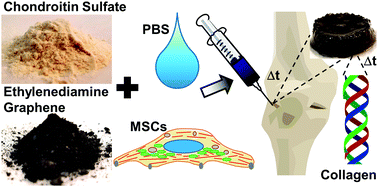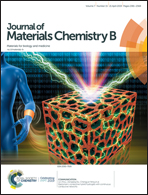Injectable amine functionalized graphene and chondroitin sulfate hydrogel with potential for cartilage regeneration†
Abstract
Damaged cartilage does not readily heal and often requires surgical intervention that only modestly improves outcomes. A synthetic material that could be injected and covalently crosslinked in situ to form a bioactive, mechanically robust scaffold that promotes stem cell chondrogenic differentiation holds promise for next-generation treatment of cartilage lesions. Here, Johnson–Claisen rearrangement chemistry was performed on graphene oxide (GO) to enable functionalization with a primary amine covalently bound to the graphenic backbone through a chemically stable linker. The primary amines are used to form covalent crosslinks with chondroitin sulfate, an important component of cartilage that promotes regeneration, to form a hydrogel (EDAG–CS). The EDAG–CS system gels in situ within 10 min, and the graphenic component imparts improved mechanical properties, including stiffness (320% increase) and toughness (70% increase). EDAG–CS hydrogels are highly porous, resistant to degradation, and enable the growth of human mesenchymal stem cells and their deposition of collagen matrix. This system has potential to improve clinical outcomes of patients with cartilage damage.



 Please wait while we load your content...
Please wait while we load your content...